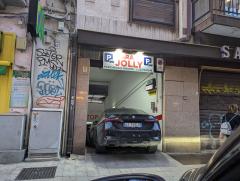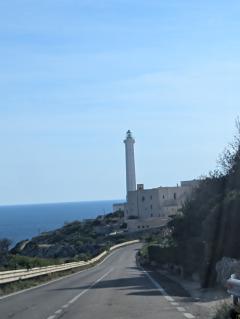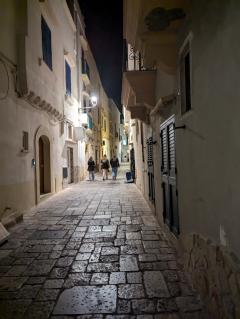 The southern part of Puglia forms the spiked heel of the Italian boot. That was our territory to explore on Thursday, 30 May. We planned to drive southward down through the middle and the eastern side to Santa Maria di Leuca at the southern tip, over 700 miles from Trieste and over 1,000 miles from Prague. From that southern outpost we would drive north along the Ionian Sea to the ancient Greek port of Gallipoli. Along the way we would see the famous conical white trulli houses of Alberobello, and then the olive groves and vineyards and the stunning Mediterranean views of the southern and western parts of this remote corner of the remote and enchanting region of Puglia.
The southern part of Puglia forms the spiked heel of the Italian boot. That was our territory to explore on Thursday, 30 May. We planned to drive southward down through the middle and the eastern side to Santa Maria di Leuca at the southern tip, over 700 miles from Trieste and over 1,000 miles from Prague. From that southern outpost we would drive north along the Ionian Sea to the ancient Greek port of Gallipoli. Along the way we would see the famous conical white trulli houses of Alberobello, and then the olive groves and vineyards and the stunning Mediterranean views of the southern and western parts of this remote corner of the remote and enchanting region of Puglia.
 But first we had to escape Bari. This was harder than it should have been. I had parked the car at an unobtrusive underground garage in the new city a short walk beyond the ancient gate. In the morning I set out to retrieve it while Lorna and Melissa got ready. The "hotel" had a nice breakfast set up and a nice woman serving it, but nobody else working and no helpful information about how to get back to the garage. Once I got out the gate, the streets of the new city were sunlit and crowded and everything looked alike. It took about half an hour to find the entrance, and there was no way in and no signage to indicate how to get my car. Finally a police officer showed me another entrance around the block on another street where I met an employee and got my car.
But first we had to escape Bari. This was harder than it should have been. I had parked the car at an unobtrusive underground garage in the new city a short walk beyond the ancient gate. In the morning I set out to retrieve it while Lorna and Melissa got ready. The "hotel" had a nice breakfast set up and a nice woman serving it, but nobody else working and no helpful information about how to get back to the garage. Once I got out the gate, the streets of the new city were sunlit and crowded and everything looked alike. It took about half an hour to find the entrance, and there was no way in and no signage to indicate how to get my car. Finally a police officer showed me another entrance around the block on another street where I met an employee and got my car.
 We made an attempt at a big outdoor market, but the parking would have been hard to get into and impossible to get out, so we escaped from Bari and headed out into the sun-baked countryside of the heel of the boot, a region known as Salento.
We made an attempt at a big outdoor market, but the parking would have been hard to get into and impossible to get out, so we escaped from Bari and headed out into the sun-baked countryside of the heel of the boot, a region known as Salento.
We drove south along the coast to Polignano a Mare and Monopoli, both pretty but not especially interesting after all we had seen already. As the spiked heel of the Italian boot, Salento has a long Adriatic Coast to the east, a somewhat long coast along the Ionian Sea to the west, and the tip of the heel at Santa Maria de Leuca faces south across the Mediterranean Sea to Africa. Ruins from medieval times back to ancient Greece are common.
 The inland part of the Salento includes a few charming white sun-baked cities. We drove inland to the celebrated UNESCO-recognized white conical trulli houses of Alberobello, which we really enjoyed, and where we had another excellent lunch.
The inland part of the Salento includes a few charming white sun-baked cities. We drove inland to the celebrated UNESCO-recognized white conical trulli houses of Alberobello, which we really enjoyed, and where we had another excellent lunch.
Trulli are white conical structures, originally used for storing agricultural tools in the countryside. People soon learned that these structures tend to stay cool during the punishing Puglian summers, so they became to local home of choice for those who could live in a small space. Today you see them in the middle of Alberobello (see the top photo), often connected by passageways to make a large home. Some are available as vacation homes or for rent on AirBnB.
 Our lunch in Alberobello was excellent. We ate at the friendly Vino e Amore, where we enjoyed an antipasto of grilled vegetables sott'olio followed by the Puglian classic orecchiette (pasta) con cima e rape (broccoli rabe), some caciocavallo and stracchino (another local white cow’s milk cheese), and local mussels with rice & potatoes. This was nowhere near as opulent as yesterday's lunch with Rocco, but it was all authentically local and the server was pleased that I understood the local pride of the various dishes. Everything was well prepared and perfectly fresh, and the server was a charming fellow who took great interest in ensuring our satisfaction.
Our lunch in Alberobello was excellent. We ate at the friendly Vino e Amore, where we enjoyed an antipasto of grilled vegetables sott'olio followed by the Puglian classic orecchiette (pasta) con cima e rape (broccoli rabe), some caciocavallo and stracchino (another local white cow’s milk cheese), and local mussels with rice & potatoes. This was nowhere near as opulent as yesterday's lunch with Rocco, but it was all authentically local and the server was pleased that I understood the local pride of the various dishes. Everything was well prepared and perfectly fresh, and the server was a charming fellow who took great interest in ensuring our satisfaction.
 From Alberobello we drove south through Locorotondo, Martina Franca, Ceglie Messapica, Ostuni and the locally major city of Lecce, population 95,000. Lecce was crowded and unattractive from the road and we decided it would be more fun to continue the drive along the coast. From Otranto it was a sunny blue-sky day and a glorious drive along the last of the Adriatic Sea to the Mediterranean Sea at Santa Maria di Leuca!
From Alberobello we drove south through Locorotondo, Martina Franca, Ceglie Messapica, Ostuni and the locally major city of Lecce, population 95,000. Lecce was crowded and unattractive from the road and we decided it would be more fun to continue the drive along the coast. From Otranto it was a sunny blue-sky day and a glorious drive along the last of the Adriatic Sea to the Mediterranean Sea at Santa Maria di Leuca!
In Santa Maria de Leuca, I had to deal with a crisis at work. I had good connectivity, so I sat at the Bar Riz and had water and a Panzerotto of ham & mozzarella while Lorna and Melissa explored that pretty little seaside town. In less than an hour I had the work situation under control and they had seen all that they had wanted to see of Santa Maria di Leuca, so we set out northward along the Ionian Sea to the ancient Greek port of Gallipoli, now a thriving beach and yacht destination.

Gallipoli is not the same place as the Turkish peninsula made famous in the Mel Gibson movie about the catastrophic World War I battle. It's a busy modern seaside town with a causeway out to an island on which sits the quaint old city. Driving was even more confusing than usual; the causeway brings you right out to the old town, and there's ample public parking along the causeway with easy walking access to the old town, but the entrance to the parking is only from the new town, off the rotary that leads to the causeway. I had a couple of nice scenic drives around the old town before I finally found the entrance to the parcheggio.
 Our hotel was another adventure. As is often the case in Italy, our "hotel" (the Dimora Storica Briganti) was really just a few rooms in a old building, operated by another hotel in the new city. When we arrived in Gallipoli, we had to check in at the real hotel in the new city, and then go to the space in the old city with a key-code. Of course Lorna and Melissa wanted some extra bath towels and they fortunately remembered to ask for them in a new city because they'd have been unavailable in the old city.
Our hotel was another adventure. As is often the case in Italy, our "hotel" (the Dimora Storica Briganti) was really just a few rooms in a old building, operated by another hotel in the new city. When we arrived in Gallipoli, we had to check in at the real hotel in the new city, and then go to the space in the old city with a key-code. Of course Lorna and Melissa wanted some extra bath towels and they fortunately remembered to ask for them in a new city because they'd have been unavailable in the old city.
There's no parking in the old city, so I had to idle the car while we unloaded everything and brought it down a long alley to the "hotel". Our rooms were upstairs on what Europeans call the first floor; there was an elevator to make it easy to bring up the bags, except it jammed and I was stuck in there for about half an hour while two local people helped unjam it because (of course) the new city hotel people were mostly off-duty and no help at all. In the end it was a nice room, but I could have done with a little less complication on my vacation.
 Melissa needed some rest from that adventure, while Lorna and I brought the car back into the new city and around the rotary to the parking area, then we had a really lovely walk along the waterfront looking at the lights of the old city and the lighthouse. Finally we found some dinner at Scoglio delle Sirene and it was excellent!
Melissa needed some rest from that adventure, while Lorna and I brought the car back into the new city and around the rotary to the parking area, then we had a really lovely walk along the waterfront looking at the lights of the old city and the lighthouse. Finally we found some dinner at Scoglio delle Sirene and it was excellent!
We had an insalata Caprese and some Frisella Pugliese (fried soft bread “crostini”), Cozze alla Cartoccio (mussels in a blue cheese cream steamed in aluminum foil folded up to look like a swan!). We were enjoying it so well that we summoned Melissa from her rest. In just a few minutes she joined us, and we carried on with our feast: I had local Gamberoni di Gallipoli (deep red “violet” shrimp of Gallipoli) served in a melon, along with Aragosta (Mediterranean spiny lobster with no claws, our lobster is Astici). Lorna had grilled sea bream, Melissa had penne with tomato and vegetables, and they finished with lemon sorbet and a gelato-chocolate truffle.
 The aragosta was something of an experiment, an attempt to vindicate an unsatisfactory one that I'd had in Genoa in 2015. We're very lucky to live near a good lobster pound in Plymouth, where we get steamed lobsters that are perfectly fresh, living in water circulated from the harbor right up until they get cooked. In Genoa I was unimpressed with the spiny lobster, but knowing their exalted reputation in old European cuisine, I suspected that maybe it was simply a matter of it being more like a supermarket lobster, picked from an overcrowded tank of tap water supplemented with packaged "authentic ocean salt". I could see that these spiny lobsters were fresh that day, so I spent the money on another try. Italians don't normally steam lobsters, they cut them and grill them, as shown here. My aragosta was definitely fresher and tastier that then Genoese one was, but I still think that steaming is a better preparation than grilling.
The aragosta was something of an experiment, an attempt to vindicate an unsatisfactory one that I'd had in Genoa in 2015. We're very lucky to live near a good lobster pound in Plymouth, where we get steamed lobsters that are perfectly fresh, living in water circulated from the harbor right up until they get cooked. In Genoa I was unimpressed with the spiny lobster, but knowing their exalted reputation in old European cuisine, I suspected that maybe it was simply a matter of it being more like a supermarket lobster, picked from an overcrowded tank of tap water supplemented with packaged "authentic ocean salt". I could see that these spiny lobsters were fresh that day, so I spent the money on another try. Italians don't normally steam lobsters, they cut them and grill them, as shown here. My aragosta was definitely fresher and tastier that then Genoese one was, but I still think that steaming is a better preparation than grilling.
After that fine dinner, remembering our long drive along three seas, we took a scenic route back to our rooms and slept long and well.
